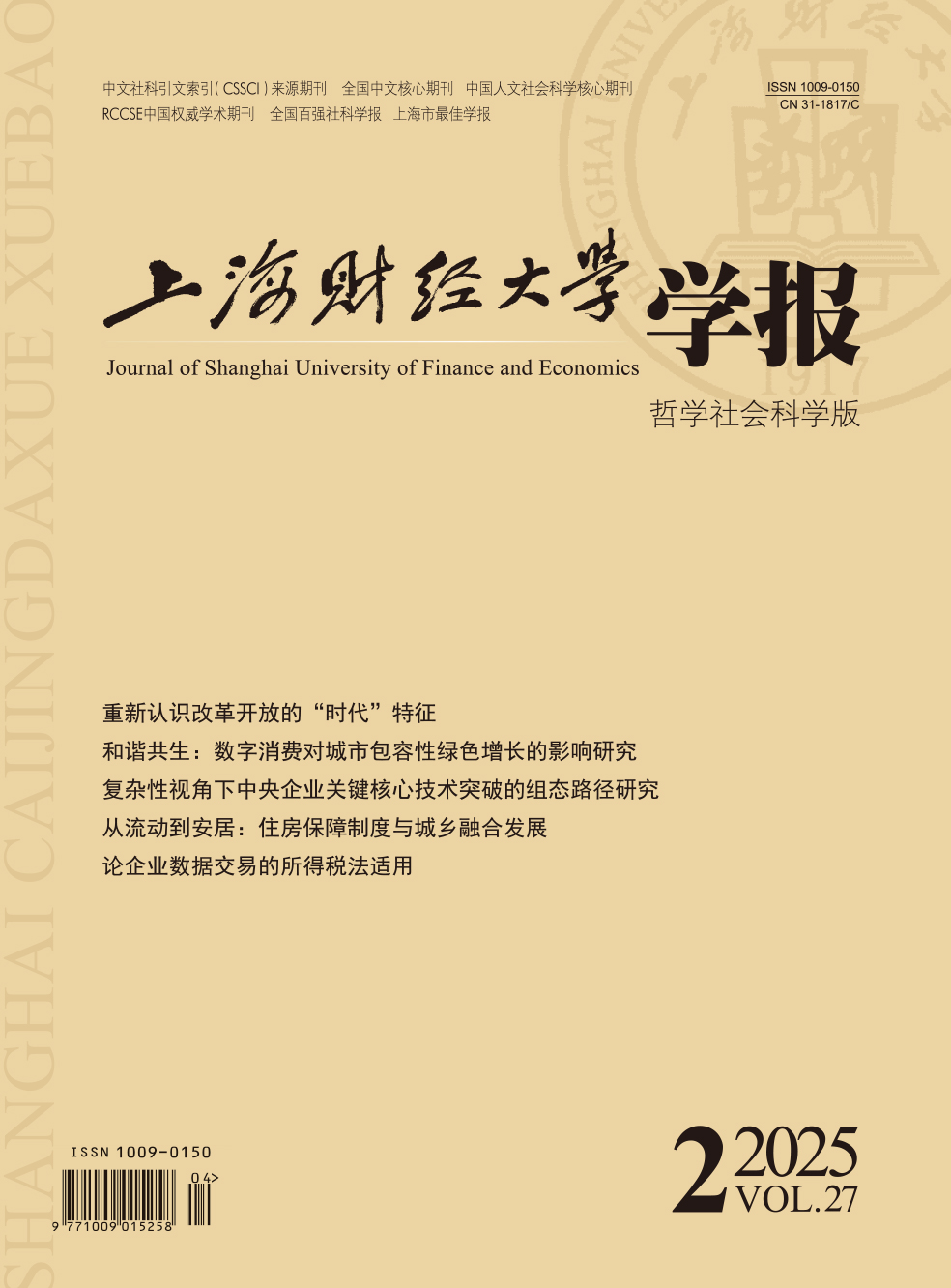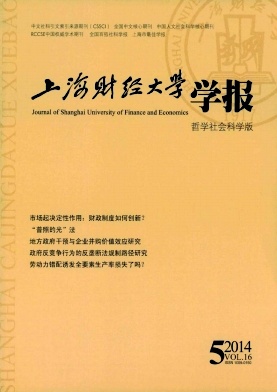劳动力错配诱发全要素生产率损失了吗?——来自中国产业层面的经验证据
上海财经大学学报 2014 年 第 16 卷第 05 期, 页码:94 - 103
摘要
参考文献
摘要
发展中国家要素过度投入和无效配置现象普遍,前沿研究关注技术进步和要素配置对经济效率的影响,却并未重视非完全市场经济条件下要素错配可能会引发效率损失。文章以产业层面的劳动力错配为视角,利用1978-2010年数据考察我国分行业劳动力配置的扭曲程度并测算其对全要素生产率的影响。结果发现:无论是传统农业还是现代金融业,所有行业均出现要素错配现象且不同行业劳动力错配分化趋势明显,抑制了全要素生产率的增长,使其表现出多头"W"形变化趋势,并平均使全要素生产率降低20%左右。当然,这主要是劳动力有偏性配置、劳动报酬不平等和市场进入障碍的影响,使劳动力无法自由流动而引发不均衡配置所致。
[1]白重恩,钱震杰.国民收入的要素分配:统计数据背后的故事[J].经济研究,2009,(3).
[2]林毅夫,蔡昉,李周.竞争、政策性负担与国有企业改革[J].经济社会体制比较,1998,(5).
[3]盛仕斌,徐海.要素价格扭曲的就业效应研究[J].经济研究,1999,(15).
[4]盛誉.贸易自由化与中国要素市场扭曲的测定[J].世界经济,2005,(6).
[5]宋冬林,王林辉,董直庆.技能偏向型技术进步存在吗?[J].经济研究,2010,(5).
[6]苏永照.技术进步偏向对中国劳动力市场的影响[J].财贸研究,2010,(1).
[7]王德文,王美艳,陈兰.中国工业的结构调整、效率与劳动配置[J].经济研究,2004,(4).
[8]姚战琪.生产率增长与要素再配置效应:中国的经验研究[J].经济研究,2009,(11).
[9]郑毓盛.中国地方分割的效率损失[J].中国社会科学,2003,(1).
[10]朱喜,史清华,盖庆恩.要素配置扭曲与农业全要素生产率[J].经济研究,2011,(5).
[11]陈永伟,胡伟民.价格扭曲、要素错配和效率损失:理论和应用[J].经济学(季刊),2011,(10).
[12]袁志刚,解栋栋.中国劳动力错配对TFP的影响分析[J].经济研究,2010,(7).
[13]蔡昉,王德文,都阳.劳动力市场扭曲对区域差距的影响[J].中国社会科学,2001,(2).
[14]Aoki S.A Simple Accounting Framework for the Effect of Resource Misallocation on Aggregate Productivity[R].MPRA Paper,No.11511,2008a.
[15]Aoki S.Was the Barrier to Labor Mobility an Important Factor for the Prewar Japanese Stagnation[R].No.8178,2008b.
[16]Berman E.,Bound J.,Griliches Z.Changes in the Demand for Skilled Labor within U.S.Manufacturing Industries:Evidence from the Annual Survey of Manufacturing[R].NEBR Working Paper,No.4255,1994.
[17]Dickens L.Shadow Prices with Variable Factor Supply and Distortion[J].Southern Economic Journal,1985,57(3):649-655.
[18]Doeringer P.An Economic Justification for Protectionism:Comment[J].Quarterly Journal of Economics,1971,75(1):133-144.
[19]Dollar D.,Wei S.Das(Wasted)Kapital:Firm Ownership and Investment Efficiency in China[R].NBER Working Paper,No.13103,2007.
[20]Fisher W.Between Plan and Market:The Role of the Local Sector in Post-Mao China[J].Journal of Comparative Economies,2000,11(3):385-398.
[21]Hsieh C.T.,Klenow P.Misallocation and Manufacturing TFP in China and India[J].Quarterly Journal of Economics,2007,124(4):1403-1448.
[22]Jaime A.P.,De Melo.Distortions in the Factor Market:Some General Equilibrium Estimates[J].Review of Economics and Statistics,1977,59(4):398-405.
[23]John J.R.Sectoral Elasticities of Substitution between Capital and Labor in a Developing Economy:Time Series Analysis in the Case of Post War Chile[J].Econometrist,1971,40(2):311-326.
[24]Mundlak Y.Serra.Substitutability and Price Distortion in the Demand for Factors of Production:An Empirical Estimation[J].Applied Economics,1970,9(3):203-217.
[25]Pakko M.R.Investment-Specific Technology Growth:Concepts and Recent Estimates[J].Federal Reserve Bank of St.Louis Review,2002:37-48.
[26]Rogerson R.Structural Transformation and the Deterioration of European Labor Market Outcomes[J].Journal of Political Economy,2008,116(2):235-259.
[27]Syrquin M.Productivity Growth and Factor Reallocation in Chenery.Industrialization and Growth.Oxford[M].Oxford University Press,1986.
[28]Temple R.W.Jonathan.Structural Change and Europe’s Golden Age[R].University of Bristol Discussion Paper,2001:501-519.
[2]林毅夫,蔡昉,李周.竞争、政策性负担与国有企业改革[J].经济社会体制比较,1998,(5).
[3]盛仕斌,徐海.要素价格扭曲的就业效应研究[J].经济研究,1999,(15).
[4]盛誉.贸易自由化与中国要素市场扭曲的测定[J].世界经济,2005,(6).
[5]宋冬林,王林辉,董直庆.技能偏向型技术进步存在吗?[J].经济研究,2010,(5).
[6]苏永照.技术进步偏向对中国劳动力市场的影响[J].财贸研究,2010,(1).
[7]王德文,王美艳,陈兰.中国工业的结构调整、效率与劳动配置[J].经济研究,2004,(4).
[8]姚战琪.生产率增长与要素再配置效应:中国的经验研究[J].经济研究,2009,(11).
[9]郑毓盛.中国地方分割的效率损失[J].中国社会科学,2003,(1).
[10]朱喜,史清华,盖庆恩.要素配置扭曲与农业全要素生产率[J].经济研究,2011,(5).
[11]陈永伟,胡伟民.价格扭曲、要素错配和效率损失:理论和应用[J].经济学(季刊),2011,(10).
[12]袁志刚,解栋栋.中国劳动力错配对TFP的影响分析[J].经济研究,2010,(7).
[13]蔡昉,王德文,都阳.劳动力市场扭曲对区域差距的影响[J].中国社会科学,2001,(2).
[14]Aoki S.A Simple Accounting Framework for the Effect of Resource Misallocation on Aggregate Productivity[R].MPRA Paper,No.11511,2008a.
[15]Aoki S.Was the Barrier to Labor Mobility an Important Factor for the Prewar Japanese Stagnation[R].No.8178,2008b.
[16]Berman E.,Bound J.,Griliches Z.Changes in the Demand for Skilled Labor within U.S.Manufacturing Industries:Evidence from the Annual Survey of Manufacturing[R].NEBR Working Paper,No.4255,1994.
[17]Dickens L.Shadow Prices with Variable Factor Supply and Distortion[J].Southern Economic Journal,1985,57(3):649-655.
[18]Doeringer P.An Economic Justification for Protectionism:Comment[J].Quarterly Journal of Economics,1971,75(1):133-144.
[19]Dollar D.,Wei S.Das(Wasted)Kapital:Firm Ownership and Investment Efficiency in China[R].NBER Working Paper,No.13103,2007.
[20]Fisher W.Between Plan and Market:The Role of the Local Sector in Post-Mao China[J].Journal of Comparative Economies,2000,11(3):385-398.
[21]Hsieh C.T.,Klenow P.Misallocation and Manufacturing TFP in China and India[J].Quarterly Journal of Economics,2007,124(4):1403-1448.
[22]Jaime A.P.,De Melo.Distortions in the Factor Market:Some General Equilibrium Estimates[J].Review of Economics and Statistics,1977,59(4):398-405.
[23]John J.R.Sectoral Elasticities of Substitution between Capital and Labor in a Developing Economy:Time Series Analysis in the Case of Post War Chile[J].Econometrist,1971,40(2):311-326.
[24]Mundlak Y.Serra.Substitutability and Price Distortion in the Demand for Factors of Production:An Empirical Estimation[J].Applied Economics,1970,9(3):203-217.
[25]Pakko M.R.Investment-Specific Technology Growth:Concepts and Recent Estimates[J].Federal Reserve Bank of St.Louis Review,2002:37-48.
[26]Rogerson R.Structural Transformation and the Deterioration of European Labor Market Outcomes[J].Journal of Political Economy,2008,116(2):235-259.
[27]Syrquin M.Productivity Growth and Factor Reallocation in Chenery.Industrialization and Growth.Oxford[M].Oxford University Press,1986.
[28]Temple R.W.Jonathan.Structural Change and Europe’s Golden Age[R].University of Bristol Discussion Paper,2001:501-519.
引用本文
董直庆, 刘迪钥, 宋伟. 劳动力错配诱发全要素生产率损失了吗?——来自中国产业层面的经验证据[J]. 上海财经大学学报, 2014, 16(5): 94–103.
导出参考文献,格式为:





 7137
7137  423
423

